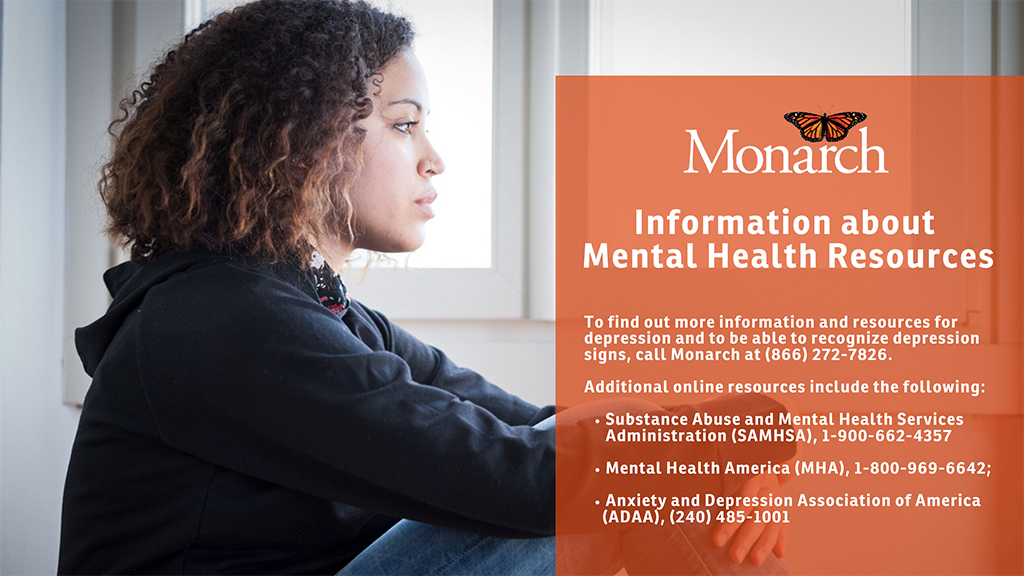How to Tell If Someone You Know is Depressed

Depression could be described as a sad, rainy day, foggy feeling. For some individuals, the feeling may be worse. Signs can vary from person to person, with each painting a differing picture of what it means to experience depression firsthand.
What is depression?
Depression is defined as a diagnosis of a minimum of two weeks of low mood or anhedonia, a psychological condition characterized by the inability to experience pleasure in everyday activities.
However, short bouts with sadness are a normal part of life, but if symptoms last longer than two weeks the diagnosis may be depression, explained Monarch Executive Vice President and Chief Medical Director Dr. Nora Dennis, MD, MSPH.
“Depression is not simply a feeling, but a physical experience,” pointed out Dr. Dennis. “There can be changes in a person’s sleep, appetite, energy level, the way their body feels, actually feeling heavy because of the way you think about the problems in your life. You might not be able to see the good and the positive – only the things that are negative in your life and possibly feel overwhelming guilt or anxiety.”
Types of depression can include:
- Major Depression: Severe symptoms interfering with the ability to work, sleep and concentrate. This kind of depression is one of the most common illnesses affecting 6.7 percent (more than 16 million) of American adults each year.
- Persistent Depression (dysthymia): Less severe symptoms than major depression but lasting a long period of time.
- Minor Depression: Similar symptoms to major depression, but not lasting as long.
Additionally, Dr. Dennis explained that atypical depression is a variant of the diagnosis characterized by an increase in appetite and possibly sleep, and more likely to occur in women than men.
In women, depression signs can most commonly exhibit as a downcast, unhappy mood. In men, depression may be presented as anger or irritability. Dr. Dennis explained that both men and women when experiencing depression can become withdrawn and have low energy, with no desire to do their usual activities.
In children, depression can be noticeable as persistent sadness or depressive symptoms that interfere with social activities, interests, schoolwork or family life. Other signs in children might include anger, social withdrawal, changes in appetite or sleep or difficulty concentrating.
Depression Risk Factors
Family history can be a reliable indicator. “If you have had a parent who experienced depression, the chances of you being diagnosed are significantly higher,” Dr. Dennis noted. Women often experience an increased risk of depression in addition to individuals who have undergone trauma.
Dr. Dennis suggested seeking a healthcare provider’s expertise if a person is struggling with depression. “Get clarity on how long the experience has been going on, how different the behavior is from their usual self and any contributing factors,” she suggested, noting that drugs and/or alcohol can worsen the mood and make diagnosis more challenging.
Mental Health America (MHA) estimates that only about a third of those experiencing severe depression seek treatment through a mental health professional. According to Dr. Dennis there is “significant misunderstanding” that depression is volitional and can be worked out or resolved. “The way that your brain metabolizes the illness, you can’t think your way healthy. Depression is one of the most common disabilities globally. Depression definitely happens to you and doesn’t define who you are,” she clarified.
Treatment Options
Treatment for depression can be determined by a healthcare provider, once the individual is diagnosed, with options that can include peer support, support groups, psychotherapy, medication and/or case management.
How Can You Help?
“You can help to encourage them and not to pretend. Engage in behavioral activation by getting them out of bed and active. Be encouraging,” Dr. Dennis suggested.

Posted on: Sunday September 29, 2019
